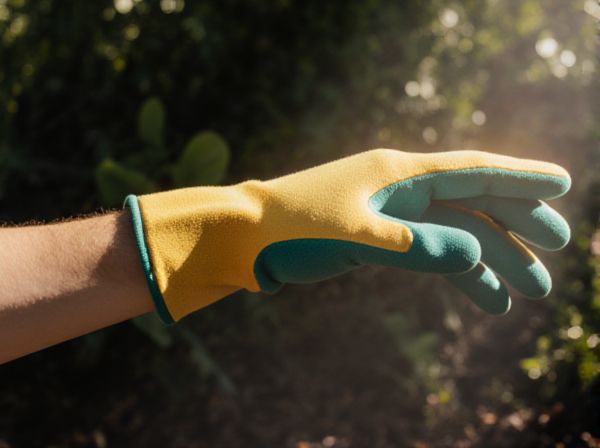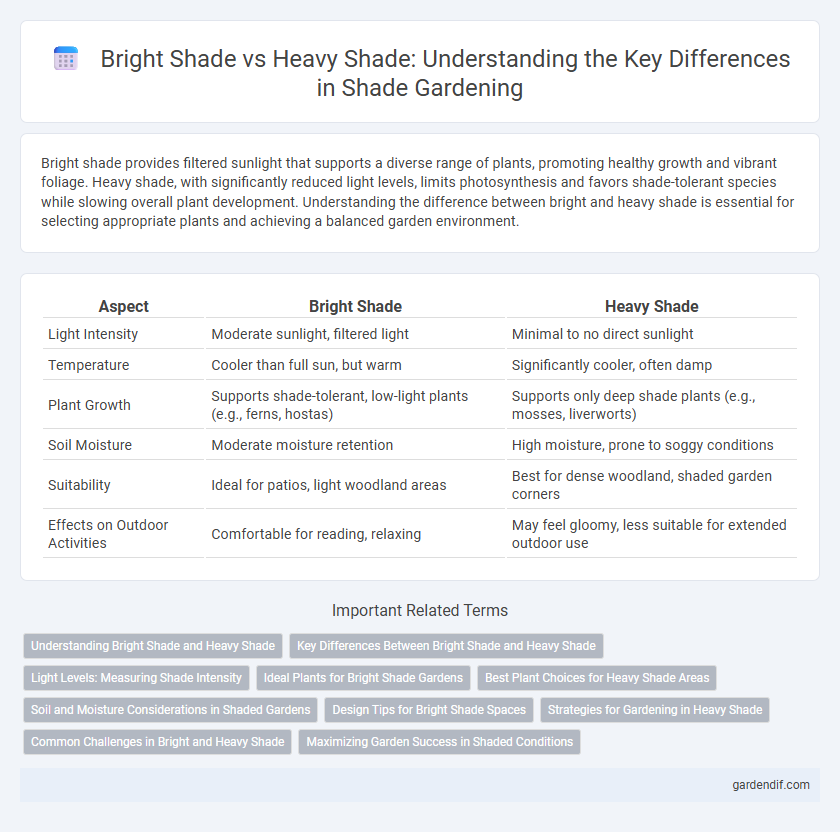
bright shade vs heavy shade Illustration
Bright shade provides filtered sunlight that supports a diverse range of plants, promoting healthy growth and vibrant foliage. Heavy shade, with significantly reduced light levels, limits photosynthesis and favors shade-tolerant species while slowing overall plant development. Understanding the difference between bright and heavy shade is essential for selecting appropriate plants and achieving a balanced garden environment.
Table of Comparison
| Aspect | Bright Shade | Heavy Shade |
|---|---|---|
| Light Intensity | Moderate sunlight, filtered light | Minimal to no direct sunlight |
| Temperature | Cooler than full sun, but warm | Significantly cooler, often damp |
| Plant Growth | Supports shade-tolerant, low-light plants (e.g., ferns, hostas) | Supports only deep shade plants (e.g., mosses, liverworts) |
| Soil Moisture | Moderate moisture retention | High moisture, prone to soggy conditions |
| Suitability | Ideal for patios, light woodland areas | Best for dense woodland, shaded garden corners |
| Effects on Outdoor Activities | Comfortable for reading, relaxing | May feel gloomy, less suitable for extended outdoor use |
Understanding Bright Shade and Heavy Shade
Bright shade occurs in areas that receive filtered sunlight or indirect light for most of the day, supporting a wider variety of plants that thrive in moderate light conditions. Heavy shade refers to locations with minimal to no direct sunlight, often beneath dense tree canopies, where only shade-tolerant species can survive. Understanding the differences between bright shade and heavy shade helps gardeners select appropriate plants and optimize growth based on light availability.
Key Differences Between Bright Shade and Heavy Shade
Bright shade refers to areas receiving indirect or filtered sunlight, allowing moderate light intensity suitable for shade-tolerant plants. Heavy shade occurs in locations with dense canopy coverage or structures that block most sunlight, resulting in significantly reduced light levels and limited photosynthesis. Plants in bright shade often exhibit healthier growth and more vibrant foliage compared to those in heavy shade, which require specialized adaptations to survive.
Light Levels: Measuring Shade Intensity
Bright shade typically receives filtered sunlight, allowing light levels around 50-70%, suitable for plants needing moderate light intensity. Heavy shade has light levels below 30%, often caused by dense tree canopies or solid structures blocking most sunlight. Measuring shade intensity with a light meter ensures accurate classification, guiding optimal plant selection and garden design.
Ideal Plants for Bright Shade Gardens
Ideal plants for bright shade gardens include hostas, astilbes, and ferns, which thrive in filtered sunlight without direct exposure to intense sun. Bright shade provides enough light for vibrant foliage and flowering, making it suitable for plants that require partial sun but are sensitive to full sun damage. Choosing perennials like hellebores and bleeding hearts further enhances garden color and texture in these conditions.
Best Plant Choices for Heavy Shade Areas
Plants thriving in heavy shade require exceptional tolerance to low light conditions and limited photosynthesis. Best choices include ferns such as the Japanese Painted Fern, shade-loving perennials like hostas and astilbes, and groundcovers like pachysandra and sweet woodruff. These species exhibit robust growth, vibrant foliage, and resilience, making them ideal for dense shade areas beneath thick canopies or structures.
Soil and Moisture Considerations in Shaded Gardens
Bright shade areas receive filtered sunlight, promoting well-drained soil with moderate moisture levels that support a diverse range of shade-tolerant plants. Heavy shade zones often have compacted, moisture-retentive soil due to limited evaporation and reduced air circulation, requiring plants adapted to consistently damp conditions. Proper soil amendment and moisture management are critical for optimizing plant health and growth in varying levels of shade.
Design Tips for Bright Shade Spaces
Bright shade spaces benefit from incorporating light-colored furniture and reflective surfaces to maximize ambient light and create an airy atmosphere. Utilizing plants with vibrant foliage and textured materials adds depth and visual interest without overpowering the subtle illumination. Strategic placement of mirrors and soft LED lighting enhances brightness, making the area feel inviting and spacious despite limited direct sunlight.
Strategies for Gardening in Heavy Shade
Gardening in heavy shade requires selecting shade-tolerant plants such as ferns, hostas, and astilbes that thrive with minimal sunlight. Soil enrichment with organic matter improves moisture retention and nutrient availability crucial for plant health under dense canopy cover. Utilizing reflective mulch and creating layered planting designs enhances light diffusion, promoting robust growth in heavy shade environments.
Common Challenges in Bright and Heavy Shade
Bright shade often presents challenges like excessive heat and glare, which can cause discomfort and fading of outdoor furniture; meanwhile, heavy shade creates issues such as persistent dampness and limited photosynthesis for plants, leading to poor growth and mold development. Managing light levels and choosing appropriate plant species are essential strategies to overcome these distinct environmental stressors. Proper ventilation and selecting shade-tolerant materials can mitigate the negative effects in both bright and heavy shade settings.
Maximizing Garden Success in Shaded Conditions
Bright shade provides filtered sunlight that supports a wider range of shade-tolerant plants, enhancing photosynthesis and growth. Heavy shade, characterized by minimal direct light, requires selecting species with strong shade adaptation such as ferns, hostas, and astilbes for garden success. Optimizing soil moisture and using reflective mulch can further improve plant health in both bright and heavy shade conditions.
bright shade vs heavy shade Infographic

 gardendif.com
gardendif.com